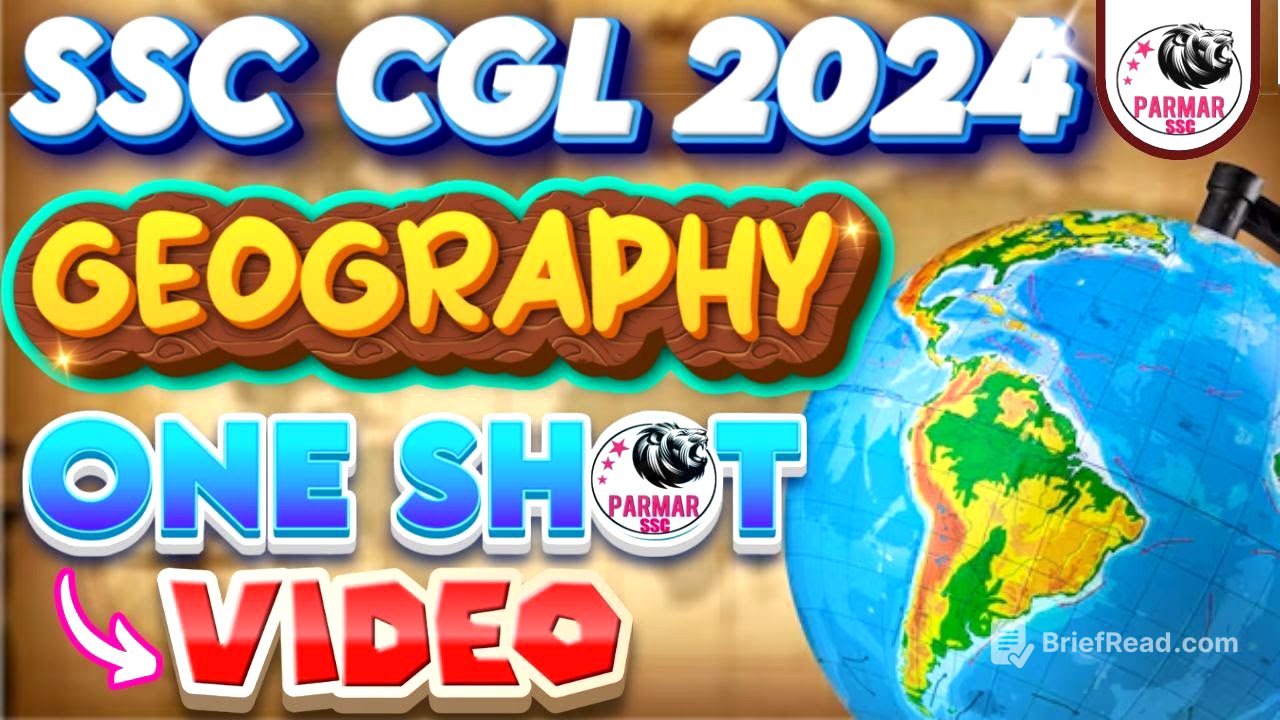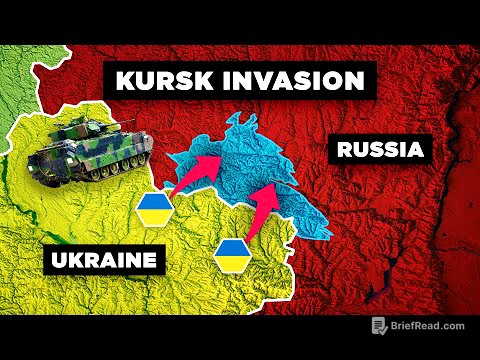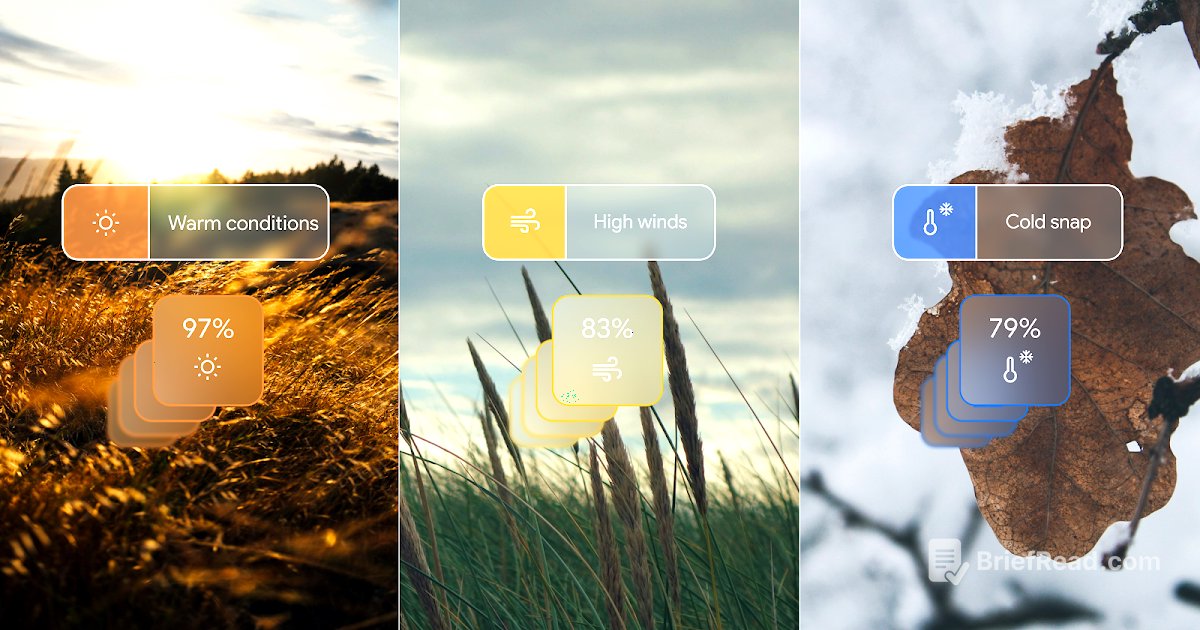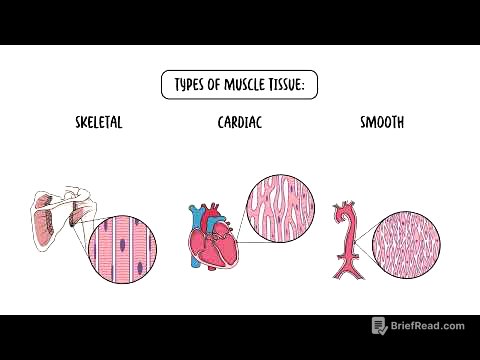TLDR;
This comprehensive geography lecture covers a wide range of topics, starting from the origin of the universe and moving through the solar system, Earth's features, climate, and Indian geography. Key points include the Big Bang Theory, constellations, the formation of the solar system, Earth's shape and movements, latitude and longitude, climate factors, types of mountains and rocks, plate tectonics, ocean currents, and various aspects of Indian geography such as river systems and soil types.
- Origin of the universe and solar system formation
- Earth's shape, movements, and imaginary lines
- Climate factors and global wind patterns
- Types of mountains, rocks, and plate tectonics
- Ocean currents and their impact on climate
- Detailed overview of Indian geography, including river systems, soil types, and agricultural practices
Introduction [0:43]
The lecture begins with a welcome and an encouragement to view the geography session in one sitting for better retention. Notes for Chemistry and Polity are available on the Telegram channel. The speaker emphasizes the importance of patience and comfortable learning, assuring that the session will cover a lot of material in a concise manner.
Origin of the Universe [3:19]
The formation of the universe is discussed, highlighting the Big Bang Theory as the most accepted explanation. According to this theory, the universe originated from a singular matter that exploded, leading to the formation of galaxies, solar systems, and planets. The Big Bang Theory was propounded by George Lemaitre. The universe is continuously expanding, a concept also proposed by George Lemaitre. An alternative Steady State Theory was given by Fred Hoyle. Cosmology is the study of the universe.
Constellations [5:51]
The lecture introduces constellations as groups of stars, focusing on those important for exams. Orion the Hunter, with its brightest star Regal, and Cassiopeia, recognized by its W shape, are highlighted. Ursa Major, also known as Sapt Rishi in India, contains an asterism called the Big Dipper. The Steady State Theory was supported by Fred Hoyle, along with Thomas Gould and Herman Bundy.
Solar System [8:40]
The evolution of the solar system from a nebula, a rotating cloud of dust and gases, is explained. The Nebula Laplace Theory, initially proposed by Immanuel Kant and later revised by Laplace in 1796, is detailed. The timeline of theories is clarified, with the Big Bang Theory proposed in 1931 and the Steady State Theory in 1948, both after the Nebula Laplace Theory. The solar system consists of the Sun at the center and eight planets revolving around it. The Aditya L1 mission has been sent to study the sun.
Planets: Mercury and Venus [11:46]
The lecture describes the planets, starting with Mercury, the closest planet to the Sun, and Venus. Mercury and Venus have no natural satellites. Mercury has the fastest revolution, completing one orbit in just 88 days. Venus has the slowest rotation, with one day on Venus equivalent to 243 Earth days. Venus is known as the Twin Sister of Earth, the Morning Star, and the Evening Star. It is the brightest and hottest planet due to high levels of carbon dioxide and sulfuric acid (H2SO4). Venus and Uranus rotate from East to West, opposite to most other planets.
Planets: Earth and Mars [15:21]
Earth is the only habitable and densest planet, known as the Blue Planet due to 71% water coverage. Mars, known as the Red Planet due to iron oxide, has two satellites, Phobos and Deimos. Earth has one natural satellite, the Moon. The Moon's rotation and revolution times are equal at 27 days, and it is a non-luminous body reflecting sunlight. Nix Olympia is the highest mountain on Mars.
Asteroid Belt and Types of Planets [17:14]
The asteroid belt, located between Mars and Jupiter, contains asteroids and dwarf planets like Ceres. Ceres is the closest dwarf planet to Earth. The asteroid belt divides the planets into interior (terrestrial) planets (Mercury to Mars) and exterior (Jovian or gaseous) planets (Jupiter to Neptune).
Planets: Jupiter and Saturn [19:42]
Jupiter is the largest planet in the solar system and has the largest satellite, Ganymede. Jupiter has four Galilean moons: Europa, Io, Callisto, and Ganymede, discovered by Galileo Galilei. Saturn has the lowest density, less than that of water, and its largest satellite is Titan. Life is potentially possible on Titan and Enceladus. Saturn has rings, first observed by Galileo. Huygens discovered the gap between the rings, and Cassini identified the black gap.
Planets: Uranus and Neptune [22:05]
Uranus and Neptune are ice giants, composed mainly of ice. Neptune has the slowest revolution, taking 165 Earth years to complete one orbit. Uranus is known as the Green Planet due to traces of methane gas. Mercury has the fastest revolution, and Jupiter has the fastest rotation.
Kuiper Belt and Shape of the Earth [23:33]
Beyond Neptune is the Kuiper Belt, containing dwarf planets like Pluto, Haumea, Makemake, and Eris. Makemake orbits the Sun in 310 years. The Earth's shape is not perfectly smooth but is a geoid or oblate spheroid, bulging at the center and flattened at the poles. This shape is due to Earth's rotation and centrifugal force. Gravity is highest at the poles due to the shorter distance to the Earth's center.
Earth's Tilt and Imaginary Lines [29:16]
The Earth is tilted 23.5 degrees on its axis and 66.5 degrees from its orbital plane. The tilt is believed to be caused by an asteroid impact. Latitude and longitude are imaginary lines used for navigation. Latitude lines are horizontal and parallel, while longitude lines are vertical and converge at the poles.
Latitude and Longitude: Facts and Concepts [31:56]
There are 181 latitude lines, with 179 being full circles. Longitude lines originate from the North Pole and meet at the South Pole, totaling 360. The distance between longitude lines is maximum at the equator (111.32 km) and decreases towards the poles, becoming zero at the poles. The distance between latitude lines is constant at 111 km. The Prime Meridian (0° longitude) passes through Greenwich, London, and is used to calculate time. The International Date Line (180° longitude) is a zigzag line where the date changes. Crossing the International Date Line from West to East gains a day, while crossing from East to West loses a day.
Key Latitudes, Hemispheres, and Time Zones [40:48]
The Equator divides the Earth into the Northern and Southern Hemispheres, while the Prime Meridian divides it into the Eastern and Western Hemispheres. India is located in the North Eastern Hemisphere. Key latitudes include the Tropic of Cancer (23.5°N), Tropic of Capricorn (23.5°S), Arctic Circle (66.5°N), and Antarctic Circle (66.5°S). Indian Standard Time is 5.5 hours ahead of Greenwich Mean Time.
Rotation and Revolution [42:49]
Rotation is the Earth's spinning on its axis, causing day and night, and takes 23 hours and 56 minutes. Revolution is the Earth's orbit around the Sun, taking 365 days, 6 hours, and 9 minutes, and is responsible for the seasons. The Earth's tilt is crucial for seasons; without it, there would be no seasonal variations.
Solstices and Equinoxes [46:02]
The lecture explains the importance of the Tropic of Cancer and Tropic of Capricorn, noting that the direct rays of the Sun never fall above the Tropic of Cancer or below the Tropic of Capricorn. The Summer Solstice (June 21) occurs when the direct rays of the Sun are on the Tropic of Cancer, and the Winter Solstice (December 22) occurs when the direct rays are on the Tropic of Capricorn. Vernal Equinox (March 21) and Autumnal Equinox (September 23) occur when the direct rays fall on the Equator, resulting in equal day and night.
Aphelion, Perihelion, and Eclipses [47:59]
Aphelion is when the Earth is farthest from the Sun (around July 4th), and Perihelion is when it is closest (around January 2nd or 3rd). Eclipses occur due to the alignment of the Sun, Earth, and Moon. A lunar eclipse happens when the Earth is between the Sun and the Moon, and a solar eclipse happens when the Moon is between the Sun and the Earth.
Lunar and Solar Eclipses [49:56]
During a lunar eclipse, the entire Moon can be visible, known as a full moon or Purnima. During a solar eclipse, the Moon blocks the Sun's light, causing darkness on Earth. A new moon or Amavasya occurs when the Moon is not visible from Earth. Partial and total solar eclipses are also discussed.
Tides [53:06]
Tides are the periodic rise and fall of sea water. High tides occur due to the gravitational pull of the Moon and the Sun. Spring tides occur when the Sun, Earth, and Moon are aligned, resulting in very high and low tides. Neap tides occur when the Sun, Earth, and Moon are at a 90° angle, resulting in less extreme tides. Centrifugal force also plays a role in tide formation.
Earth's Layers: Crust, Mantle, and Core [55:48]
The Earth is divided into three layers: the crust, mantle, and core. The crust is the outermost layer, divided into continental (thick, granite) and oceanic (thin, basalt) crust. The mantle is divided into the lithosphere (solid upper part) and the asthenosphere (semi-molten layer). The core is divided into the outer core (liquid) and the inner core (solid). The outer core's liquid state generates Earth's magnetic field, protecting it from harmful solar radiations. The crust is also known as Sial (silica and aluminum), the mantle as Sima (silica and magnesium), and the core as Nife (nickel and iron).
Discontinuity and Earth's Composition [1:01:29]
The lecture details the composition of Earth's layers by volume and mass. The crust makes up 1% by volume and 1% by mass, the mantle 84% by volume and 68% by mass, and the core 15% by volume and 31% by mass. Discontinuities, or boundaries between layers, are named after scientists: Conrad, Mohorovičić, Repetti, Gutenberg, and Lehmann.
Plate Tectonics [1:04:14]
The lithosphere is composed of moving plates that slide on the asthenosphere. There are seven major plates. Alfred Wegener proposed that all landmasses were once joined in a supercontinent called Pangea, surrounded by an ocean called Panthalassa. Arthur Holmes explained plate movement through convection currents in the asthenosphere caused by radioactive decay. Harry Hess described sea floor spreading, where magma rises and solidifies at mid-ocean ridges.
Ocean Floor Relief Features [1:10:27]
The ocean floor has major and minor relief features. Major features include the continental shelf, continental slope, continental rise, and abyssal plains. Minor features include sea mountains and guyots (flat-topped sea mounts). The Ring of Fire in the Pacific Ocean is an area of high volcanic and earthquake activity due to plate boundaries.
Plate Boundaries and Earthquakes [1:13:54]
Plates interact in three ways: diverging (moving apart), converging (coming together), and transforming (sliding past each other). Divergent boundaries create new crust, convergent boundaries destroy crust through subduction, and transform boundaries cause earthquakes. Earthquakes originate at the hypocenter or focus, and the point directly above on the Earth's surface is the epicenter. Earthquake waves are measured using a seismograph, and intensity is measured using the Mercalli scale, while magnitude is measured using the Richter scale. Body waves (P and S waves) and surface waves are the two types of earthquake waves.
Types of Mountains [1:18:44]
Mountains are classified into three types: fold, block, and volcanic. Fold mountains are formed by convergent plate boundaries and can be young (e.g., Himalayas, Andes, Alps, Rockies) or old (e.g., Aravali, Ural Mountains). Block mountains are formed by tension and faulting, resulting in horsts (uplifted blocks) and grabens (down-dropped blocks) (e.g., Vosges, Harz, Vindhya, Satpura). Volcanic mountains are formed by the accumulation of lava (e.g., Kilimanjaro, Mount Cotopaxi, Mount Strumboli, Mount Etna, Ojas del Salado).
Types of Rocks [1:25:04]
Rocks are studied in petrology, and their age is determined through carbon dating. Igneous rocks are formed from solidified magma or lava and are known as primary rocks (e.g., Gabro, Granite, Basalt, Pumice). Sedimentary rocks are formed from the accumulation and cementation of sediments (lithification) (e.g., limestone, sandstone, shale, coal). Metamorphic rocks are formed when existing rocks are transformed by heat, pressure, or chemical processes (metamorphosis) (e.g., marble, slate, quartzite).
Rock Cycle and Landforms [1:31:16]
The rock cycle describes the continuous transformation of rocks from one type to another. Linear lines or foliation and banding are features associated with metamorphic rocks. Dikes are vertical and sills are horizontal. Plutonic rocks are formed inside the earth. Batholiths are large domes formed from solidified magma chambers, while laccoliths are smaller domes. Phacoliths are lens-shaped formations in anticlines and synclines.
Weathering and Exogenic Forces [1:33:13]
Young fold mountains are still increasing in height, while old fold mountains are decreasing due to exogenic forces. Endogenic forces build up landforms, while exogenic forces break them down. Orogenic forces build mountains, and epeirogenic forces build continents. Exogenic forces are also known as denudation. Weathering is the breaking down of rocks in place, while erosion is the transportation of weathered material.
Atmosphere: Composition and Layers [1:37:19]
The atmosphere's evolution occurred in three phases: loss of primordial atmosphere, degassing, and photosynthesis. The atmosphere is held in place by Earth's gravity. The layers of the atmosphere are the troposphere, stratosphere, mesosphere, thermosphere (ionosphere), and exosphere.
Atmospheric Layers: Troposphere to Exosphere [1:40:18]
The troposphere is the lowest layer, where weather phenomena occur, and temperature decreases with height. The stratosphere features increasing temperature with height due to the ozone layer. The mesosphere is the coldest layer, where meteoroids burn up. The thermosphere (ionosphere) reflects radio waves. The exosphere is the outermost layer.
Atmospheric Composition and Hydrosphere [1:44:59]
The composition of gases in the troposphere includes nitrogen (78%), oxygen (21%), argon, and carbon dioxide. The hydrosphere covers 71% of Earth's surface, with 97.2% being salt water and 2.8% being fresh water. Most fresh water is stored in glaciers and ice caps, followed by ground water and surface water.
Climate and Factors Affecting It [1:50:12]
Climate is long-term weather patterns, while weather is short-term atmospheric conditions. Six factors determine climate: latitude, altitude, continentality, ocean currents, pressure and wind systems, and insulation. Continentality refers to the moderating influence of the sea on coastal temperatures.
Factors Affecting Climate: Wind Systems and Insulation [1:51:45]
Wind blows from high pressure to low pressure areas. Cold air is dense and sinks, creating high pressure, while warm air is light and rises, creating low pressure. The Coriolis force deflects winds to the right in the Northern Hemisphere and to the left in the Southern Hemisphere. The Intertropical Convergence Zone (ITCZ) is where North Easterly and South Easterly trade winds meet.
Global Wind Patterns and Local Winds [1:58:53]
Permanent winds include easterlies and westerlies. Westerlies in the Southern Hemisphere are known as Furious Fifties and Shrieking Sixties due to high speeds. Local winds include Loo (India), Chinook (North America), Harmattan (West Africa), and Sirocco (Mediterranean). Land breezes blow from land to sea at night, while sea breezes blow from sea to land during the day.
Ocean Currents and Their Effects [2:12:21]
Ocean currents are caused by wind, density differences, and coastlines. Warm currents move from the equator to the poles, while cold currents move from the poles to the equator. The meeting of warm and cold currents creates the best fishing zones but also hazardous fog conditions. Cold currents are often found on the western coasts of continents and contribute to desert formation.
Climate Classification and El Niño/La Niña [2:20:19]
The Köppen climate classification system uses letters to denote climate types based on temperature and precipitation. El Niño is a warm ocean current in the Pacific Ocean that can disrupt monsoon patterns, while La Niña is its counterpart, bringing early monsoons and above-normal rainfall.
Pre-Monsoon Showers and Indian Geography [2:28:18]
Pre-monsoon showers are light rains that occur before the monsoon season. They are known as Nor'westers in North East India and Blossom Showers or Mango Showers in South India. India's southernmost latitude is 8°4'N, and its northernmost latitude is 37°6'N. The westernmost longitude is 68°7'E, and the easternmost longitude is 97°25'E. The North-South distance is 3,214 km, and the West-East distance is 2,933 km.
Tropic of Cancer, Indian Standard Time, and International Boundaries [2:58:16]
The Tropic of Cancer passes through eight states of India. Indian Standard Time (82.5°E longitude) passes through five states and is 5.5 hours ahead of Greenwich Mean Time. India shares international boundaries with seven countries, with the longest boundary being with Bangladesh and the shortest with Afghanistan. The Radcliffe Line separates India and Bangladesh, and the McMahon Line separates India and China.
Coastal Boundaries and Physiographic Divisions of India [3:09:39]
India has a coastal boundary of 7,516 km, with Gujarat having the longest coastline among states and Andaman and Nicobar Islands having the longest overall. India is divided into six physiographic divisions: the Northern Mountains (Himalayas), the Northern Plains, the Peninsular Plateau, Coastal Plains, Islands, and the Great Indian Desert.
Himalayas: Formation and Divisions [3:18:39]
The Himalayas were formed by the collision of the Indian Plate with the Eurasian Plate. The Himalayas are divided into the Trans Himalayas, Great Himalayas (Inner Himalayas or Himadri), Lesser Himalayas (Middle Himalayas or Himachal), and Outer Himalayas (Shivalik). Key peaks include Mount Everest, Kanchenjunga, and K2 (Godwin Austin).
Himalayan Ranges and Passes [3:28:47]
The lecture identifies the Karakoram, Ladakh, and Zanskar ranges as part of the Trans Himalayas. The Pir Panjal range is located in Kashmir, the Dhauladhar range in Himachal Pradesh, the Nagtibba range in Uttarakhand, and the Mahabharata range in Nepal. Longitudinal valleys between the Lesser Himalayas and Shivalik are called Doons, with Dehradun being the largest. Key passes include Banihal, Pir Panjal, Zojila, Rohtang, Bara-Lacha La, Shipki La, Umling La, Nathu La, and Jelep La.
Regional Divisions of Himalayas and Peninsular Plateau [3:33:17]
The Himalayas are regionally divided into the Punjab Himalayas (between Indus and Sutlej), Kumaon Himalayas (between Sutlej and Kali), Nepal Himalayas (between Kali and Teesta), and Assam Himalayas (between Teesta and Brahmaputra). The Peninsular Plateau is an inverted triangular shape tilted from west to east, with height increasing from north to south. It is divided into the Central Highlands and the Deccan Plateau.
Central Highlands and Deccan Plateau [3:39:03]
The Central Highlands include the Marwar Plateau, Malwa Plateau, Bundelkhand Plateau, Baghelkhand Plateau, and Chhota Nagpur Plateau. The Deccan Plateau is bounded by the Narmada River, Western Ghats, and Eastern Ghats. The Western Ghats are higher and more continuous than the Eastern Ghats.
Western and Eastern Ghats [3:41:15]
The Western Ghats and Eastern Ghats meet at the Nilgiri Hills. The highest peak in the Western Ghats is Anai Mudi, located in the Anamalai Hills, while the highest peak in the Eastern Ghats is Mahendragiri. The Eastern Ghats are made up of Nalla Malla, Venta Konda, Pal Konda, Nagari Hills, Javadi Hills, Shevaroy Hills, Panch Malai, and Siru Malai.
Meghalaya Plateau and Peaks [3:43:39]
The Rajmahal Hills are the easternmost extension of the Peninsular Plateau. The Meghalaya Plateau or Karbi Anglong Plateau includes the Garo, Khasi, and Jaintia Hills. The highest peak of the Vindhya Range is the Goodwill Peak, and the highest peak of the Satpura Range is Dhupgarh.
Coastal Plains and Island Groups [3:46:48]
The coastal plains are divided into the Kutch and Kathiawar Coast, Konkan Coast, Kannada Coast, Malabar Coast, Coromandel Coast, Northern Circars, Utkal Coast, and Baiga Coast. India has two main island groups: Andaman and Nicobar Islands and Lakshadweep.
Andaman and Nicobar Islands [3:49:30]
The Andaman and Nicobar Islands are an extension of the Arakan Yoma range. The islands are divided into the Andaman group and the Nicobar group, separated by the 10-degree channel. The highest peak is Saddle Peak in North Andaman, and the second highest is Mount Thaler in Great Nicobar. Duncan Passage separates South Andaman from Little Andaman. Port Blair is the capital. Barren Island is an active volcano, and Narcondam is a dormant volcano.
Lakshadweep Islands and UNCLOS [3:52:22]
Lakshadweep is made of coral reefs. The 9-degree channel separates Minicoy Island from the rest of Lakshadweep, and the 8-degree channel separates Minicoy from the Maldives. Kavaratti is the capital. The United Nations Convention on the Law of the Sea (UNCLOS) defines maritime zones, including territorial waters (12 nautical miles) and the Exclusive Economic Zone (200 nautical miles).
Great Indian Desert and Major Ports [3:55:57]
The Great Indian Desert is located northwest of the Aravali Range and is densely populated. India has 13 major ports and 200 minor ports. Major ports include Kandla (Deendayal Port), Mumbai Port, Jawaharlal Nehru Port (Nhava Sheva), Marmagao Port, New Mangalore Port, Cochin Port, Chennai Port, Ennore (Kamarajar Port), Visakhapatnam Port, Paradip Port, and Kolkata (Shyama Prasad Mukherjee Port Trust).
River Systems: Drainage Patterns and Himalayan Rivers [4:05:00]
Drainage patterns include dendritic, radial, trellised, and centripetal. India's river systems are divided into Himalayan and Peninsular rivers. Himalayan rivers are perennial, have large catchment areas, and are antecedent in nature. Peninsular rivers are seasonal and have smaller catchment areas.
Indus River System [4:10:11]
The Indus River originates from the Bokhar Chu Glacier near Mansarovar Lake and flows through Ladakh before entering Pakistan. Its major tributaries are Jhelum, Chenab, Ravi, Beas, and Sutlej. The Indus Water Treaty of 1960 governs water sharing between India and Pakistan.
Ganga River System [4:16:49]
The Ganga River is formed by the confluence of the Alaknanda and Bhagirathi rivers at Devprayag. The Alaknanda originates from the Satopanth Glacier, and the Bhagirathi originates from the Gomukh Glacier. Key confluences (Prayags) include Vishnuprayag, Nandprayag, Karnaprayag, Rudraprayag, and Devprayag. Major left bank tributaries are Ramganga, Gomti, Ghaghra, Gandak, and Kosi. The Yamuna, originating from the Yamunotri Glacier, is the largest and longest right bank tributary.
Ganga Tributaries and Brahmaputra River System [4:23:55]
The tributaries of the Yamuna River are Chambal, Sindh, Betwa, and Ken. The Chambal River originates from the Mau Plateau and is known for gully erosion. The Son River originates from the Amarkantak Plateau. The Brahmaputra River originates from the Chema Yungdung Glacier near Mansarovar Lake and is known as the Tsangpo in Tibet.
Brahmaputra River and National Waterways [4:32:35]
The Brahmaputra enters India through Arunachal Pradesh, where it is called Dihang, and then flows into Assam, where it is called Brahmaputra. It forms Majuli, the world's largest riverine island, and enters Bangladesh, where it is called Jamuna. The Ganga and Brahmaputra merge in Bangladesh to form the Meghna River, creating the Sundarban Delta. National Waterway 1 is from Prayagraj to Haldia, National Waterway 2 is on the Brahmaputra River, and National Waterway 3 is in Kerala.
National Highways and Peninsular River Systems [4:34:44]
National Highway 44 is the longest in India, running from Srinagar to Kanyakumari. The Golden Quadrilateral connects Delhi, Mumbai, Chennai, and Kolkata. Peninsular rivers are divided into east-flowing and west-flowing rivers. East-flowing rivers form deltas, while west-flowing rivers form estuaries.
East and West Flowing Rivers [4:37:36]
East-flowing rivers include the Damodar, Baitarani, Mahanadi, Vamsadhara, Godavari, Krishna, Penneru, and Kaveri. West-flowing rivers include the Luni, Sabarmati, Mahi, Narmada, Tapi, Mandovi, Sharavati, Netravati, Bharathappuzha, Periyar, and Pamba.
Waterfalls and Dams [4:46:07]
Key waterfalls include Kunchikal and Jog (Gerosoppa) in Karnataka, Kapildhara and Dhuandhar on the Narmada River, and Hundru on the Subarnarekha River. Important dams include Bhakra Nangal, Tehri Dam, Sardar Sarovar Dam, and Nagarjuna Sagar Dam.
Soil Types and Agricultural Practices [4:53:29]
Soil horizons include the parent rock (C horizon), subsoil (B horizon), and topsoil (A horizon). Humus is dark-colored organic matter beneficial for soil health. Alluvial soil is the most abundant in India, followed by red soil and black soil. Black soil is known as Regur soil and is suitable for cotton cultivation.
Soil Conservation and Cropping Patterns [5:06:09]
Soil conservation methods include shelter belts, terrace farming, contour barriers, and stubble mulching. Cropping patterns include Rabi (winter), Kharif (monsoon), and Zaid (summer) crops.
Forest Cover and Types [5:10:53]
India's forest cover is 24.6%, with a target of 33% according to the National Forest Policy of 1988. Madhya Pradesh has the largest forest cover in area, while Arunachal Pradesh has the largest in percentage terms. Forest types include evergreen, deciduous, thorn, mangrove, and coniferous forests.
Grasslands, Oceans, and Cyclones [5:24:17]
Temperate grasslands include Pampas, Steppes, Prairies, Veldt, and Puszta. Tropical grasslands include Savanna, Campos, and Llanos. The five major oceans are the Pacific, Atlantic, Indian, Southern, and Arctic. Cyclones are formed by intense low pressure and rotate due to the Coriolis force. Tropical cyclones occur in the tropics, while temperate cyclones occur due to fronts.









